by Ludwig Heinrich Dyck
What nation of Asia, did not Xerxes lead against Hellas?
—Herodotus
On the Doricus, the vast Thracian plain and beach on the Aegean coast, rose a stronghold. From its parapets, 38-year-old Xerxes (r. 485-465 bc), the Persian “King of Kings,” beheld an ocean of humanity assembled from 46 different peoples on the plain below.
Rows of blue-black bearded Assyrians stood adorned in brass helmets, wearing linen cuirasses and wielding iron knotted clubs, lances, and daggers. Bactrian archers with bows of cane stood beside squat Scythians in trousers and pointed hats, armed with deadly composite bows and “sagaris” battle-axes. There were dusky Indian charioteers in cotton, Caspians in goatskin, Colchians behind shields of cow skin, and Saragian horsemen with lassos. The brightly adorned Thracians wore fox skin caps on their heads. Zeira, long robes, shrouded Arabian archers on camels. Wildest of all were the ebony Ethiopians, whose straight, black hair fell from beneath headdresses of horses’ scalps, ears, and manes. In contrast, those of western Ethiopia were curly haired. They draped themselves in leopard and lion skins and carried reed arrows tipped with sharpened stones like those of an earlier age. Their six-foot bows were made from the stems of palm leaves and their spearheads were of antelope horn.
Persian, Mede, and Kissian infantry and cavalry provided the backbone of Xerxes’ army. Their officers and nobles glittered all over in golden adornments. Litters bearing concubines, a throng of servants, and beasts of burden followed in their wake. Garlands ringed the heads of the “Immortals,” Xerxes’ elite troops, so named because they eternally numbered 10,000, their ranks quickly refilling if any of them perished.
If Xerxes looked from the plain to the sea, he could see that beyond his citadel the coastline gave way to a beach that wound past Sale, the city of the Samothracians, all the way to the Serrheum promontory. Along the beach was arrayed Xerxes’ massive armada of Egyptian, Phoenician, Cypriot, Cilician, Pamphylian, Lycian, Caranin, and subject Greek ships that always accompanied his land army. There were warships and smaller ships, each with a crew of 80 to 200 men who were as variedly equipped as the land army. Some of the ships were hauled ashore for refitting.
Xerxes Commanded the Most Greatest Army The World Had Ever Seen
Altogether, Herodotus, the principal source for the period, claimed that Xerxes commanded some 1,700,000 infantry, 80,000 cavalry and that his whole host, including ship crews, servants, and camp followers, numbered over five million with 1,207 warships and 3,000 smaller vessels. Logistically this number is, of course, completely impossible, a product of Greek propaganda. Modern estimates range widely but it is reasonable to assume that there were over 150,000 soldiers and marines and about 800 triremes. Nevertheless, it was the greatest military and political might the ancient world had ever seen, an army that had taken four years to marshal. Every nation and every tribe from an empire at its zenith had been required to send warriors led by their own kings and princes.
Woe to those that failed to bow to the will of Xerxes, for the Great King’s wrath was as terrible as his might. In the autumn of 481 bc, the previous year, Pythius, the richest man in the Persian Empire, entertained the King and his whole army. Xerxes was so pleased that he bestowed upon Pythius 7,000 darics, so that the latter’s wealth would amount to a full four million. The following spring, in light of Xerxes’ generous gesture, Pythius dared ask for his eldest son to be spared from the coming war against the Greeks. Furious at the audacity of a mere “slave,” Xerxes ordered Pythius’s son to be cut into two pieces. The “pieces” were displayed on either side of the gate of Sardis, in full sight of Xerxes’ army setting forth on their march to the Hellespont strait (the Dardanelles). According to legend, the sun darkened with the army’s passing.
Not even the elements were safe from Xerxes’ anger. A tempest destroyed two gargantuan bridges that his Egyptian and Phoenician engineers had thrown across the narrow Hellespont. The engineers paid for their ill luck with their heads. On Xerxes’ order the Hellespont itself was punished by 300 lashes accompanied by the exclamation, “O bitter water, our lord lays this punishment upon you, for having done him wrong, who never did wrong to you. King Xerxes will cross you, whether you will or not.”
It seemed that even the waters of the Hellespont acknowledged the will of Xerxes. Under the direction of a Greek engineer, two lines of over 300 ships each were moored over the strait to provide the foundation of two new bridges, complete with a road of brushwood, wood, and earth and side palisades. From an ivory throne, Xerxes watched for two days as his army crossed from Asia Minor into Greece. Supposedly a wide-eyed local man exclaimed, “Why, O Zeus, do you, in the likeness of a Persian man, and with the name of Xerxes instead of your own, lead the whole race of mankind to the destruction of Greece?”
The answer, in part, lay 10 years in the past, when Xerxes’ late father, King Darius, came to Greece to punish Athens for aiding rebellious Greek cities in Asia Minor. At Marathon, however, Athens humbled Darius’s army. Although it went against Xerxes’ own initial judgment, his warmongering cousin Mardonius, the conqueror of Thrace and Macedonia, prodded him to avenge his father’s humiliation and to extend his sway into Greek Europe.
Mardonius’s council bore fruit when Xerxes, a devout Zoroastrian, experienced a series of visions, including a godly identity telling him to make war on Greece. In another, Xerxes was crowned with an olive branch. Boughs spread out from the branch and covered the whole earth; then suddenly the garland, as it lay upon his brow, vanished.
The end of the dream implies that, at a time when Xerxes’ complete victory appeared certain, he would abruptly lose it all. The dreams are fanciful reading but, like many other anecdotes, could be an invention of Herodotus to enliven his story. On the other hand, the ancient world was ripe with superstitions, oracles, and soothsayers so Xerxes might well have been so inspired.
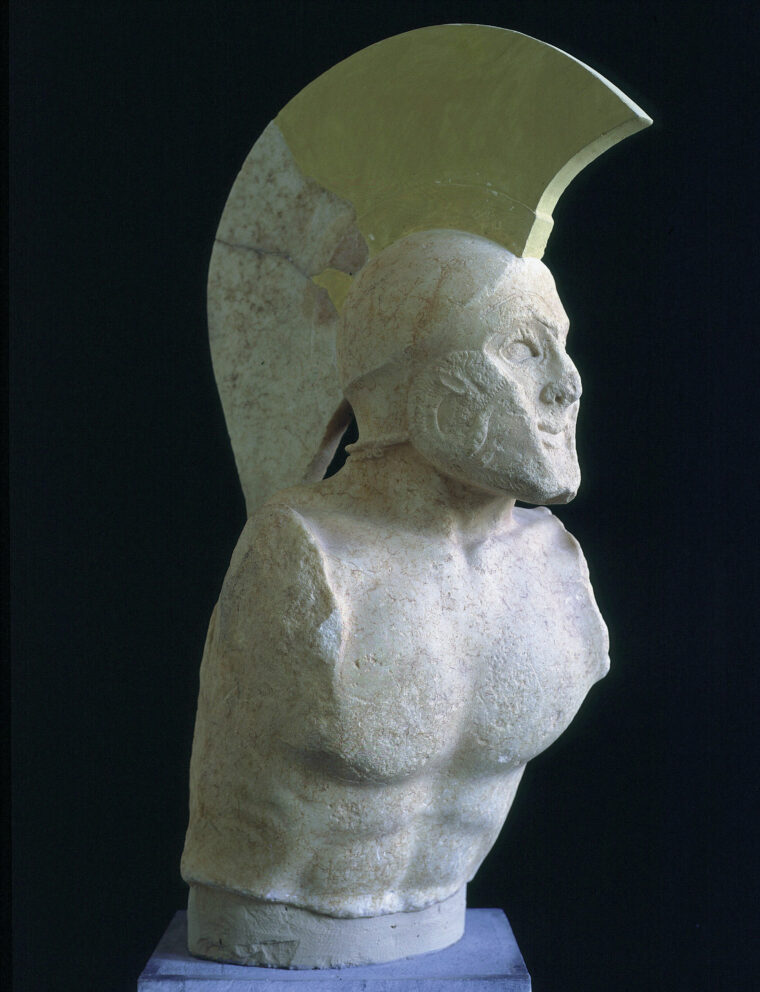
The ‘King of Kings’ Invoked Supernatural Forces to Aid His Victory
Xerxes became convinced that it was his divine right to conquer the world. Inscribed at Persepolis were the words: “A great god is Ahuramazda, who created this earth, who created man, who created peace for man; who made Xerxes king, one king of many, one lord of many.” Another of Xerxes’ inscriptions relates, “All I did, I did with the will of Ahuramazda.”
Xerxes was not the only one who invoked supernatural aid. Within the temple of the god Apollo at Delphi, the Pythia, the priestess of the most famed oracle in all of Greece, sat upon a tripod. Beside her grew a laurel tree, sacred to Apollo. Below her yawned a symbolic chasm. Chewing a laurel leaf, the Pythia drifted into a trance, her utterings recorded by priests in prose or verse. After she was done they informed a Spartan delegation awaiting her prophecy in an outer chamber.
“Oh! Ye men who dwell in the streets of broad Lacedaemon,
Either your glorious town shall be sacked by the Children of Perseus
Or, in exchange, must all through the whole Laconian country
Mourn for the loss of a king, descendant of great Heracles.
He cannot be withstood by the courage of bulls or lions,
Strive as they may; he is mighty as Zeus; there is naught that shall stay him,
Till he have got for his prey your king, or your glorious city.”
Sparta, also known as Lacedaemon, was the chief city of Laconia, the southernmost region of Greece’s prominent Peloponnesus peninsula. The Isthmus of Corinth connected the Peloponnesus to the eastern mainland. Just on the other side rose Athens.
Sparta and Athens were the only two Greek city-states that did not receive Persian heralds demanding earth and water, the symbolic tokens of submission. They would not have given them anyway, for the Greeks could not and would never accept “one king of many,” not even from their own people, much less from the Persians whom they considered to be a race of “barbarians.”
The first seeds of Panhellenism germinated during the previous Persian invasion. Under the leadership of Sparta and Athens they blossomed into the Synedrion of Probuloi or the Congress of Representatives, held at the Isthmus of Corinth in the autumn of 481. Long-standing feuds between Greek city-states were buried as delegates from 31 city-states met to forge a Panhellenic policy against the Persian invader.
The congress was under the presidency of Sparta, already the leader of a large number of Peloponnesian cities. Furthermore, it was to the dual monarchy of Sparta that the leadership of both the army and the navy was nearly unanimously entrusted. The only major opposition came from Athens. Unlike Sparta, which was primarily a land-based power, Athens easily boasted the largest navy within the confederation and naturally wished to command this combat arm. However, when petty jealousy of the Athenian democracy threatened disunity, Athens graciously relinquished her claim.
The leader of the army would be Leonidas, one of the dual Spartan kings, who traced his lineage back to Heracles. Eurybiadas, a Spartan who curiously was not a member of either of the royal families, presided over the navy.
Not all the Greek states joined the confederation. Absent were Argos, Sparta’s old rival, and the isolated island cities of Crete, Corcyra, and Syracuse. Also abstaining was the wild northeastern region of Thessaly and a number of smaller northern states to her south. Since Xerxes would march west from Thrace and then through his vassal kingdom of Macedon, Thessaly would be the first free Greek realm to feel the tramp of the Persian colossus. With no concrete help forthcoming from the southern Greeks, and many of her hill tribes won over by Persian agents, Thessaly could not afford to incur the Great King’s wrath by openly supporting the Greek confederation.
The Greeks probably realized from the beginning that their chances of defeating the Persians in an open land battle were slim. There was not only the matter of greater Persian numbers, but the excellent Persian cavalry could easily outflank the Greek hoplite heavy infantry. The only formidable Greek cavalry was that of Thessaly, but the confederation had abandoned Thessaly. Besides, the Persian horsemen outmatched the Thessalian cavalry.
Because the Greek navy at least enjoyed a qualitative advantage, the only hope was a decisive sea battle. So the Greek plan developed that a crack corps of hoplites would hold the pass of Thermopylae, the gateway to central and southern Greece. Their mission would be to forestall the Persian land advance long enough for the Persian navy to attempt an outflanking maneuver in the adjacent Euboean channel. Blocking them at the mouth of the channel, in the Malian Gulf, would be the Greek navy.
Sparta Hesitantly Agreed to Defend Thermopylae
It was Athens that pushed for this strategy because she did not wish to see the Persian army pour into central Greece and up to the gates of her city. Sparta, on the other hand, was too introverted to look beyond the defense of her own peninsula. She preferred a stand on the Isthmus of Corinth with the Greek navy stationed in the adjacent straits of Salamis. But because Sparta depended on the help of the Athenian navy, she reluctantly agreed on the defense of Thermopylae.
Sparta’s hesitation was reflected in her committing a mere 300 of her several thousand “Spartiatai” hoplites to Thermopylae’s defense. They were likely accompanied by an additional 900 lighter-armed “helot” hoplites. The difference between a Spartiatai and a helot was that the Spartiatai was the military ruling class of Sparta, descended from Dorian conquerors, while the helot was the more numerous indigenous, bottom-caste farmer-serfs. Although the helots provided a handy base for additional recruits, they constantly threatened to revolt against their brutal oppression and provided another reason as to why Sparta could ill afford to empty her city of all its Spartiatai hoplites.
Sparta, of course, admitted neither her self-centered view nor her internal problems. She officially blamed the current Feasts of the Carnean Apollo (seemingly a winter Spartan celebration ending as a full moon waned) and the Olympics on her lack of available soldiers. These festivals, however, did not curtail the actions of the allied fleet; on the other hand, it would be quality and not quantity that mattered, and of the bravery of the 300 Spartiatai, the bodyguards of King Leonidas, there was no question.
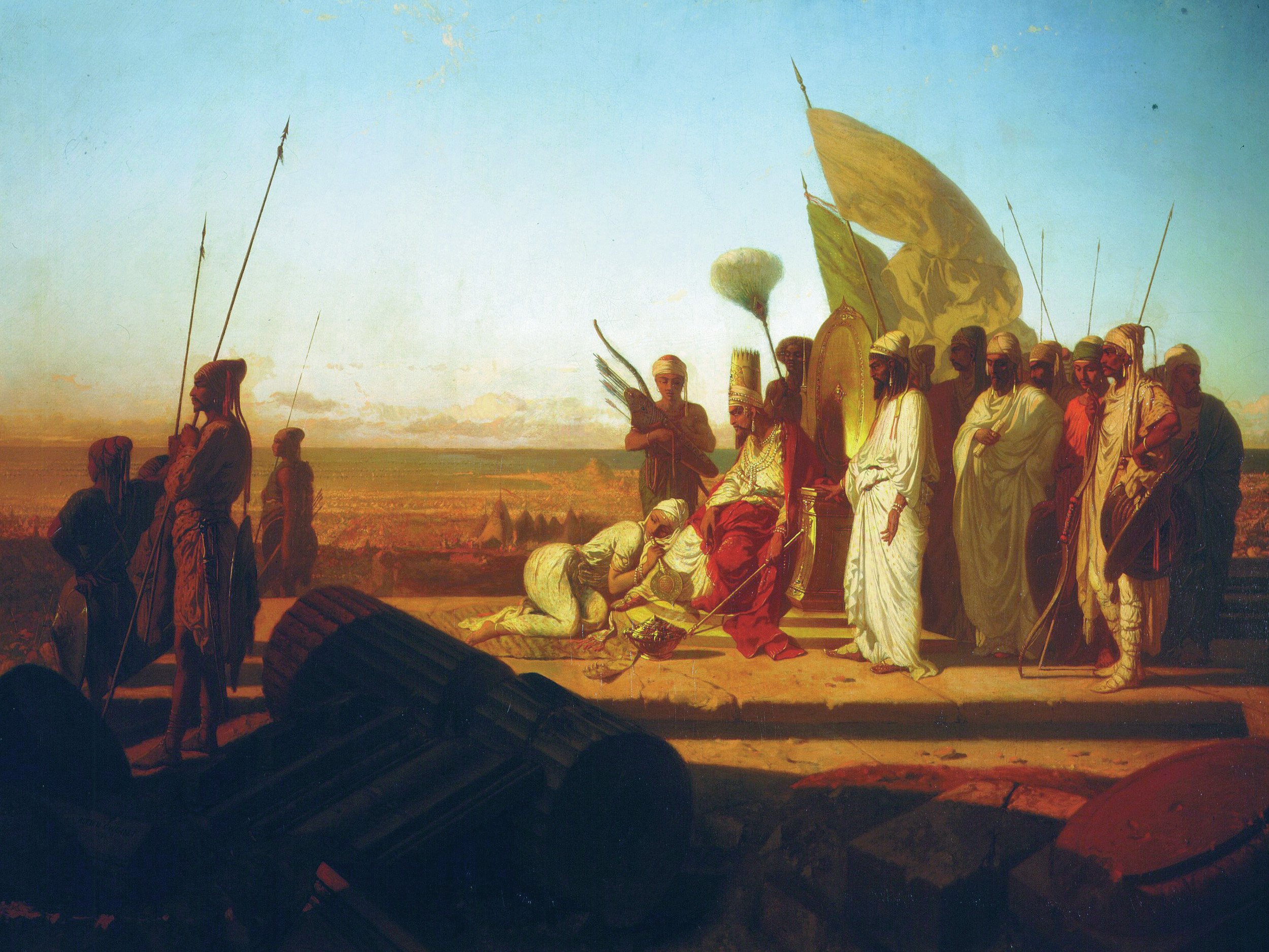
In Arcadia, the mountainous region of the inner Peloponnesus, Leonidas mustered a further 2,100 soldiers. Another 400 men joined him from Corinth, 200 from Phleious, and 80 from Mykenai. With 4,000 or so hoplites from the Peloponnesus, Leonidas crossed to mainland Greece, marching past farmhouses, orchards, vineyards, and stone field walls. Seven hundred Thespians, 1,000 Phocians, 400 Thebans, and a small number of Locrians rallied to Leonidas’s side. By the time he got to Thermopylae in the summer of 480 bc, Leonidas commanded about 7,000 troops. There were no Athenians among them. They received a Delphic prophecy of their own, advising them to seek safety “behind the wooden wall,” interpreted as the hull of their ships by the Athenian naval proponent, Strategos (General) Themistocles. Themistocles convinced all but a handful of Athenians to concentrate their manpower in their navy.
Thermopylae literally means the “gates of heat,” being named after local hot sulfur springs. Here the coastal road wound along the northern slope of Mount Kallidromus. To the west, the pass led past the famous shrine of the fertility goddess Demeter at the village of Anthela, and beyond that the road crossed the Asopus River. To the east was the Locrian village of Alpenoi.
The western, middle, and eastern parts of the pass were very narrow, a mere 50 feet wide in some parts. In the middle there remained the ruins of a wall, built by the Phocians to keep guard against Thessaly, which Leonidas forthwith repaired. The only way to circumvent the pass was a small, steep trail called the Anopaea, the guarding of which was assumed by the 1,000 Phocians. Because Xerxes was still in Thessaly, Leonidas had time to lead a night raid into the Malian plain to the northwest. Flaming farmsteads lit up the dark. Leonidas’s warriors took what food and cattle they needed and destroyed the rest to deny it to the oncoming enemy.
Meanwhile, the Greek navy of 271 triremes and nine penteconters took position near Artemisium on the northern tip of Euboea Island at the mouth of the Malian Gulf. An additional 53 ships remained near the southern tip of Euboea to prevent the Persians from slipping around and cutting off any chance of retreat for the Greek main fleet.
In mid-August the Persian army arrived in the Malian valley. Out at sea the Persian fleet sailed down Thessaly’s rugged coast and destroyed two out of three Greek reconnaissance ships. But soon after, fortune played into the hands of the Greeks. Lack of suitable coastline forced the bulk of the Persian fleet to anchor offshore. The night was calm, but soon after dawn the waters rippled in anticipation of a tempest that thundered down from the east as if driven by the anger of a god. The Persians frantically pulled what ships they could onto the shore, but for many others there was no escape. Frothing waters dashed ships to pieces along the rocky shoreline and dragged crews beneath the waves. For three long days the sea raged while Xerxes’ mystic Magians attempted to appease the winds, the sea goddess Thetis, and the sea nymph Nereids with sacrifices. On the fourth day their efforts appeared to lull the storm.
Persian Fleet Destroyed by Poseidon?
When Euboean scouts reported to their countrymen of the Persian fleet’s disaster, the Euboeans hailed the great sea god Poseidon as their savior and poured libations in his honor. The Athenians for their part claimed that Boreas, the God of the North Wind, had come to their aid. The lucky incident somewhat revived the morale of the Greek navy. Faced with the sheer might of the Persian navy and the initial loss of the Greek reconnaissance ships, many Greeks had been ready to withdraw.
Indeed, even with their losses to the storm, the Persians still had many more ships than the Greeks. The Persian fleet probed farther around Euboea’s northern tip, deploying at Aphetae on the opposite shore. Two hundred Phoenician ships detached themselves to sail along the open ocean coast of Euboea and round its southern cape to bottle up the Greek fleet in the Malian Gulf.
Urged on by Themistocles, the confederate fleet chanced an engagement with the Persians in the afternoon of August 18. The massive Greek ships initially sank a number of Persian ships, which set forth from their harbors piecemeal. More and more Persian ships threatened to encircle the Greeks who slashed back from a kuklos—a defensive formation of Greek ships facing bow outward, stern inward, like the spokes of a wheel. When darkness fell the Greeks withdrew, having captured 30 ships.
Some days earlier, Leonidas took position at the repaired Phocian wall. Below to the west, on the Malian plain, awaited the Persian multitude. Xerxes knew that despite the pitiful number of Greeks, it would not be easy to take the narrow pass. He chose to wait, the mere sight of his mighty host would cause the Greeks to lose heart!
Indeed, fear took hold of many of the Greeks who watched Xerxes’ multitude in awe. How could a handful of mere mortals face the fury of such an army? Most of the Peloponnesians called for a retreat back to the isthmus. Such words roused anger in the hearts of the Lorcians and Phocians. They had marshaled every fighting man they could, but without the Peloponnesians they had no chance. Their lands would be forfeited to Xerxes. Struck by the Locrian and Phocians’ predicament, Leonidas decided to continue the defense and sent envoys for further help.
Xerxes wished to know what was going on and sent a rider up the pass. When the mounted scout reined in his steed some distance from the Phocian wall, he witnessed a strange sight. The Spartans held vigil in front of the wall and were apparently oblivious to his presence. Some were engrossed in gymnastics while others combed their long, oily hair, hair that was the privilege of veterans.
When the scout reported back to Xerxes, the Great King at first laughed about the antics of the Greeks! He called upon Demaratus, a dethroned Spartan king who had fled to the Persians in the time of Darius. A somber Demaratus enlightened Xerxes: “It is their custom,” he said, “when they are about to hazard their lives, to adorn their heads with care. Be assured, however, that if you can subdue the men who are here and the Lacedaemonians, there is no other nation in all the world which will venture to lift a hand in their defense.”
Xerxes brooded: How could so few warriors contend the pass? Why were they not fleeing? For four days Xerxes waited, but the stubborn Greeks refused to budge. But how could Xerxes understand the true nature of the Spartans, who were martial anomalies even within the warlike Greek culture?—Spartans, whose struggle began at birth when only the fit were allowed the gift of life, while the weak were exposed in the wilderness or cast down a cliff; Spartans, who were taught by their slave nurses not to fear darkness or solitude. Torn from their mothers at seven or eight years old, they henceforth devoted their whole lives to the state. Although they could marry, they could not farm, nor craft, nor trade, nor own gold or silver. For them there was only constant drill, athletics, and training, and a life devoid of any comforts. Their rations were so meager that they were encouraged to steal. If caught they were beaten, not for stealing but for getting caught! They existed solely for Sparta, to crush her enemies and reduce the conquered to helots.
In light of his army’s size and the prior raiding carried out by Leonidas, Xerxes found the store of salted meats and grains consumed by his army to be running low. Supply dumps had been set up, but both the army and navy depended heavily on a fleet of supply ships. However, many had succumbed to the storm, while the Greek navy blocked those that remained. Like a plague of locusts, the Persian army needed to move and pillage to survive. On the fifth day, August 18, the day of the naval battle at Aphetae, Xerxes’ patience ran out. He would teach those foolish Spartans a lesson!
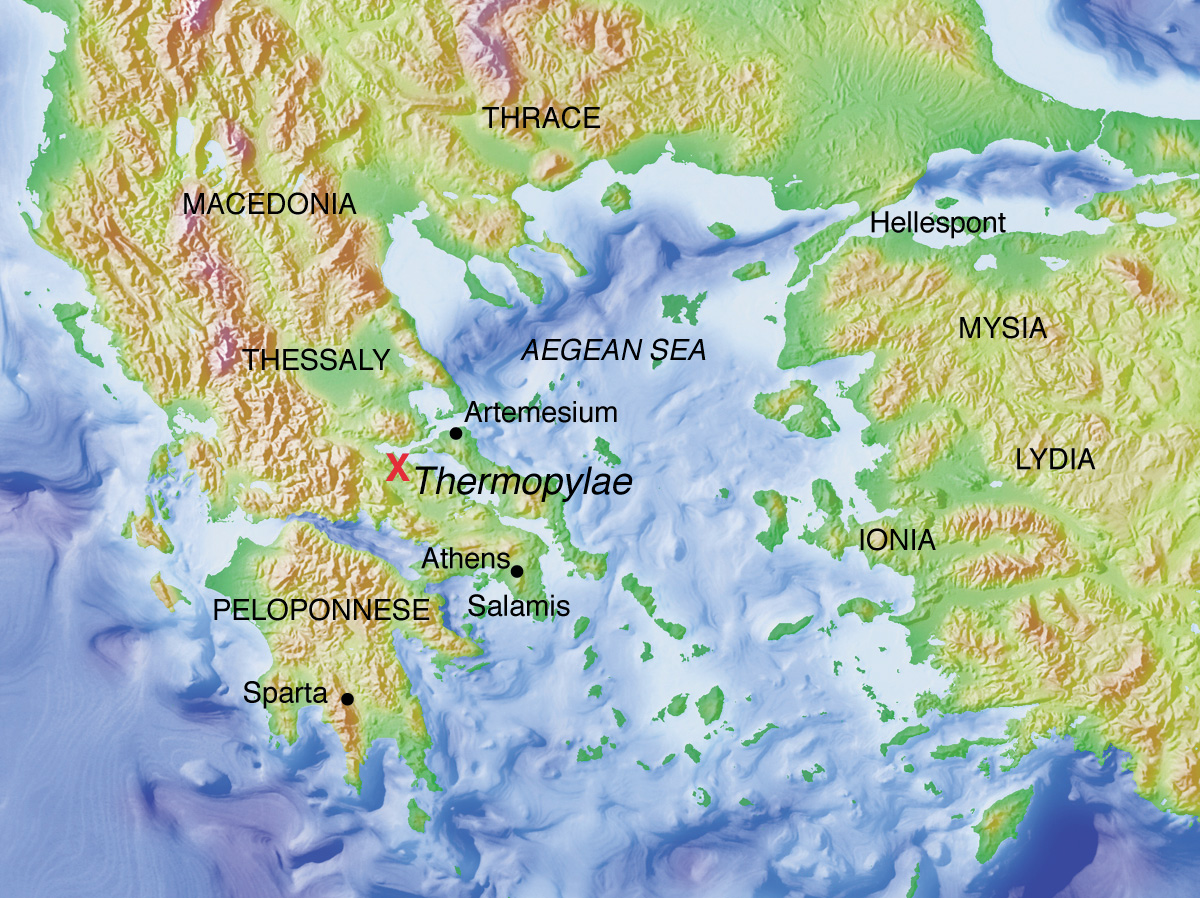
Xerxes Commands His First Assault Against the 300 Spartans
For the first assault Xerxes chose his Medes and Kissians from central Persia. Likely Xerxes begrudged the Medes’ former lordship over the Persians and thus cared not if they perished. Foolishly, he even ordered them to capture the defenders alive.
Led by Tigranes the Achae-menid, the Medes marched at the front of the column while the Kissians brought up the rear. The pass became ever more narrow. On their left, the banks dropped to the sparkling blue waters of the Malian Gulf, while to their right tall bushes sprawled up the towering slopes of Mount Kallidromus. The going was hard, the parched ground cracked in the merciless heat of the Greek summer.
Tigranes and his men paused. Ahead a solid wall of bronze, shining fiery red in the sun and bristling with huge spears, blocked the pass. The Spartans wore bell corselets (the thôrax) of polished bronze. Bronze greaves protected their shins. Cloaks, dyed red to mask the blood, draped from their shoulders.
Spartan eyes burned with singular determination out of T-shaped helmet slits. The helmet was beaten out of a single sheet of bronze that protected the whole head, including the cheeks, nose, and collarbone. A leather inner lining gave limited protection from concussions. A massive horsehair crest proudly ran along the crown of the helmet, turned transverse for the officers. Named after Corinth, the city of its origin, the “Corinthian” helmet was a masterpiece of metalcraft.
As superb as the hoplite’s body armor was, his principal protection was a huge, three- or four-foot-wide round shield. It was so indispensable to the Greek phalanx that its depth was usually referred to by the number of shields, instead of the number of spears or warriors. Made of oak but covered in bronze, the hoplite shield was held by a handgrip and strapped to the left arm to distribute the weight. Even then, weighing in at 20 pounds, it got so heavy that its upper rim was often rested upon the shoulder. The shield protected the hoplite’s left side and the right side of his neighbor. Upon it was emblazoned the Greek letter for L, for Lacedaemon, the mere recognition of which could cause foes to run in fear.
But the Greek “L” did not intimidate the Medes who, like the Persians, were tough, professional soldiers. They would not let Xerxes’ personal feelings get in their way or heed his “capture alive” order. Still, Tigranes must have cursed. If only he could outflank the Greeks and with arrows pepper the vulnerable right side of the hoplite phalanx, the side not guarded with shields. But the pass was too narrow; his men would have to fight on the Spartans’ terms!
Although Herodotus makes no mention of it, the Medes probably tried to “soften” the Spartan phalanx with missile fire. Typically, eastern archers fired from behind the protection of shields set into the ground. Composite bows twanged and arrows whistled through the air. But precious few bronze arrowheads penetrated flesh as most thudded harmlessly into the great shields or were deflected by nearly invulnerable 1/4-inch-thick bronze breastplates.
The proud Medes gritted their teeth, grasped the shafts of their short spears, and hurled themselves at their foes. Greek iron spear points crunched through Medish mail, shattered wicker shields, and shred through the Medes’ charge like sharp rocks tear asunder an angry wave. Although crack Mede and Persian troopers sported bronze or iron dome-shaped helmets and tunics of bronze “fish scales,” their armor was inferior to that of the Greeks. The rank and file had no body armor whatsoever, with naught on their heads but a soft hat or a piece of cloth to shade them from the sun.
More than that, eastern tactics relied on the fluid maneuver of the cavalry, the marksmanship of the archer, and the fighting power of the individual. On the open plain such tactics could pay dividends, but not at Thermopylae, which was tailor-made for hoplite shock tactics.
Unlike the Middle Eastern troops, the Greeks fought as a tight unit. Soldiers served their entire career in platoons of two dozen, known as “sworn bands.” Members were not only friends but often lovers as well and to a Greek, nothing seemed nobler than to die for one’s lover. The bravest hoplites fought at the front, their comrades forming eight or more ranks behind them. Deep ranks buffered staying power as they prevented those in the combat zone from fleeing. The Spartan poet Tyrtaeus captures the spirit of the Spartan tactics: “Standing foot to foot, shield pressed on shield, crest to crest and helmet to helmet, chest to chest engage your man, grasping your sword hilt or long spear.”
In the heat and chaos of combat, the rows and files intermingled. Cohesion was maintained through the melodies of accompanying flutists. The high-pitched tones resounded even within the enclosed Corinthian helmets. Lighter armed helot servants farther to the rear aided their injured masters and dispatched enemy casualties. Wounded hoplites that managed to stagger out of the fray were the lucky ones. Those that went down amid the chaos were doomed. Weighed down by their excessive armor, trampled by friend or foe, blood loss and shock meant death within minutes.
Stabbing with spears, pushing with shields, peripheral vision cut off, and sound muffled by helmets while bearing the burden of 50 to 70 pounds of sun-baked bronze, iron, and wood hopla (combat gear) strained even the Spartans to their limits. Their combat feats are even more astounding considering that based on skeletal evidence, the average hoplite stood 5 feet 6 inches tall and weighed 140 pounds.
The Elite Persian Immortals vs. the Spartans and Hoplites
Whenever there was a break in the fighting, the Greeks took the opportunity to usher in rested troops and put the weary ones into reserve. In such a way, they fought in detachments drawn up according to their cities, though always under Spartan leadership. The only ones that did not fight during that day and the next were the Phocians who remained guarding the Anopaea trail.
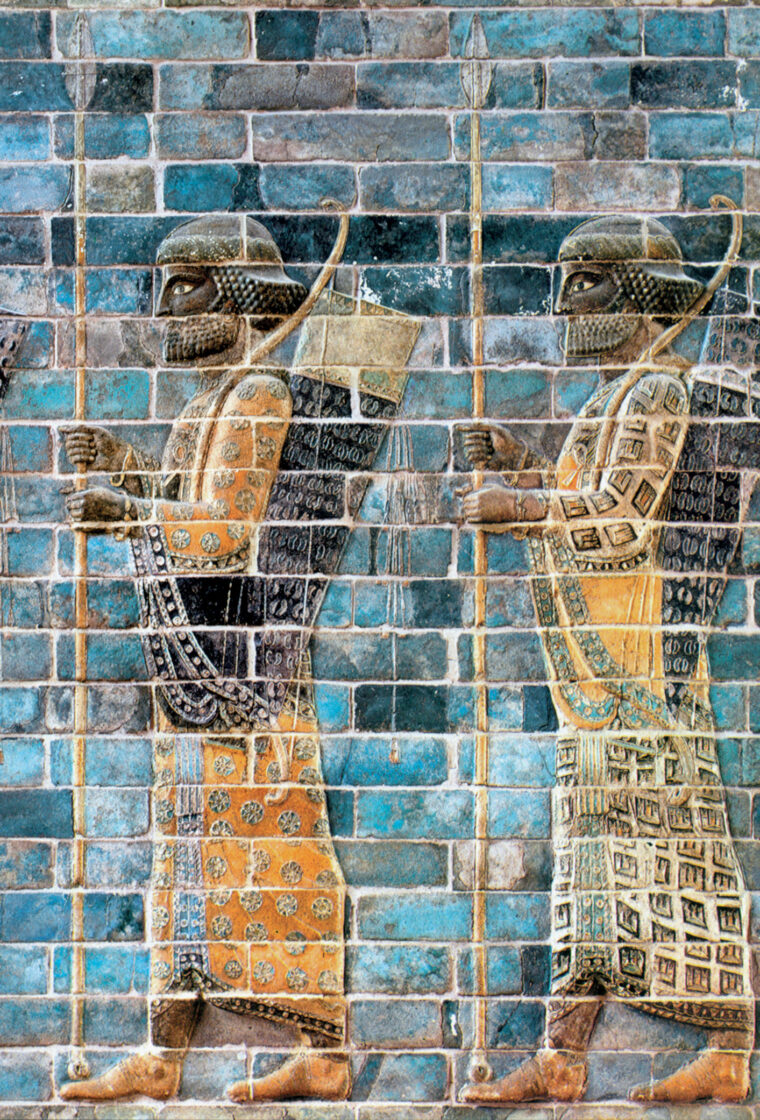
Still, on came the Medes, the living stomping the bodies of the slain till they too joined them in death. Finally, the exhausted survivors limped back down to the plain in defeat. The Kissians had no more luck, if they fought at all, for Herodotus does not mention them in combat.
With the failure of his first assault, Xerxes ordered forth his crack Immortals under their leader Hydarnes. They marched forth in false confidence. The Immortals may have been the best trained and armored of the Persians but they still could not match the hoplites in close combat.
The Immortals presumably drenched the Spartans with sustained volleys of arrows and javelins until suddenly the Greek line cracked. With shouts of panic, the hoplites turned their backs and fled! Letting loose a cry for vengeance, the Immortals bolted after them, but the fleeing Greeks maintained their order. With a change in their flutists’ tune the hoplites wheeled about as one, their spears shearing the strung-out Persian pursuers to pieces.
By nightfall, the Greeks watched their enemy depart. Even the Immortals had to admit they had met their match. Here and there a Greek also lay slain. Persian spears had gashed into unprotected throats, thighs, and groins. The casualties were highest among the non-Spartans, many of whom were in leather armor or Persian-style composite scale mail. But the Greek losses were nothing compared to the crimson-stained heaps of the enemy sprawled across the path. Xerxes thrice “sprang from his throne in agony for his army.”
It was time for the Greeks to tend wounds, eat, rest, recuperate their sore muscles, and gain back their spent strength. Although triumphant, not one of them was under the illusion that it was over.
At night the Greek watchmen drew their cloaks about them as the wind picked up and turned into a torrential downpour. Toward the north, thunder and lightning cracked upon the crags of Mount Pelion. Out at sea, the storm whipped the waters into a frenzy. It caught the 200 Phoenician ships just as they skirted the southern tip of Euboea through a perilous coastline known as the Hollows. Only a little farther and they could have reached the safer waters of the Euboean channel. Instead the Phoenician ships were wrecked upon the rocks.
With dawn the sun returned, its rays basking the Persian army as Xerxes drew up fresh contingents of regular Persian troops. He promised them lavish rewards in return for victory and terrible punishments in face of defeat. The Persian trooper stared in dismay upon the indomitable hoplites and the swaths of mangled Mede, Kissian, and Immortal corpses, the latter’s colorful patterned outfits streaked in blood. The Persians had no stomach for a futile fight. Xerxes did not care. The overseers’ whips cracked and drove the Persians onto the Greek pikemen and to their deaths.
With the second day no better than the first, Xerxes’ ire increasingly turned to desperation. Certainly there were other ways to get over the mountains, but they would take too long. His scouts quite possibly even found the western trailhead of the Anopaea but had no idea where it led. Fortune finally smiled upon Xerxes when a local Malian Greek named Epialtes offered to guide the Persians along the Anopaea to a point behind the defenders of Thermopylae.
The night before the full moon that Sparta linked to its Carnean festival, Epialtes led Hydarnes and his Immortals across the Asopus River gorge and between the two ridges of Mount Kallidromus. Their armor shone softly in the moonlight as the Immortals picked their way around thorny shrubs and through oak woods. Although the climb was tough and steep at first, there was no slack in the Immortals’ pace. They were trained in mountain country and were driven by their desire to get even with the troublesome Greeks.
Dawn found the Immortals cresting a plateau along which the trail snaked eastward. Somewhere ahead lay the Phocians who were supposed to be guarding the trail. Instead, the whole lot of them were asleep and without their armor. Despite the fighting in the pass below, they had not bothered to post guards. A few of them were suddenly given a rude awakening by the rustling of leaves. Sleepy-eyed Phocians stared in disbelief at the long line of Persians swishing through oak leaves that carpeted the trail.
Initially startled at the sight of the shouting and panicked Phocians, Hydarnes quickly recovered and called up his archers who drew back bowstrings and let arrows rip. The Phocians did not even put up a semblance of a fight but high-tailed it farther up the mountainside, presumptuously considering that they were the main objective of the attack. The contemptuous Immortals marched past them. The victory boosted their morale while the presence of the Phocians confirmed that they were on the right trail.
Back at Thermopylae, the seer Megistias examined the innards of his sacrificial animal. To Megistias they foreshadowed death at dawn. It was still dark when deserters drifted in, telling the Greeks that the Persians were on the Anopaea. Before dawn scouts confirmed the ominous prophecy and the deserters’ rumors.
Leonidas and His 300 Spartans
The Greeks at once held a heated council of war. The Spartans, Thebans, and Thespians decided to remain in the pass while the other Greeks pulled back eastward and eventually returned to their homelands. The 300 Spartans and 900 helots would hold Thermopylae against the entire Persian army while the 1,100 remaining Thebans and Thespians would guard the Spartans’ rear against Hydarnes’ approaching Immortals.
The reasoning behind the results of the defender’s last war council has been a matter of much speculation. For Leonidas and the Spartans, their code of honor dictated that they should fulfill their duty till the end. Outflanked, their death was ascertained. The strategic objective of holding the pass and forcing the Persians into a decisive sea battle in the adjacent Malian Gulf was lost. All that Leonidas could do now was to delay the Persians long enough for his less courageous Greek allies to make good their escape. If he failed, the fleeter Persian cavalry would catch up with and cut down the fleeing Greeks in the open. Leonidas may have even ordered the other Greeks to retreat.
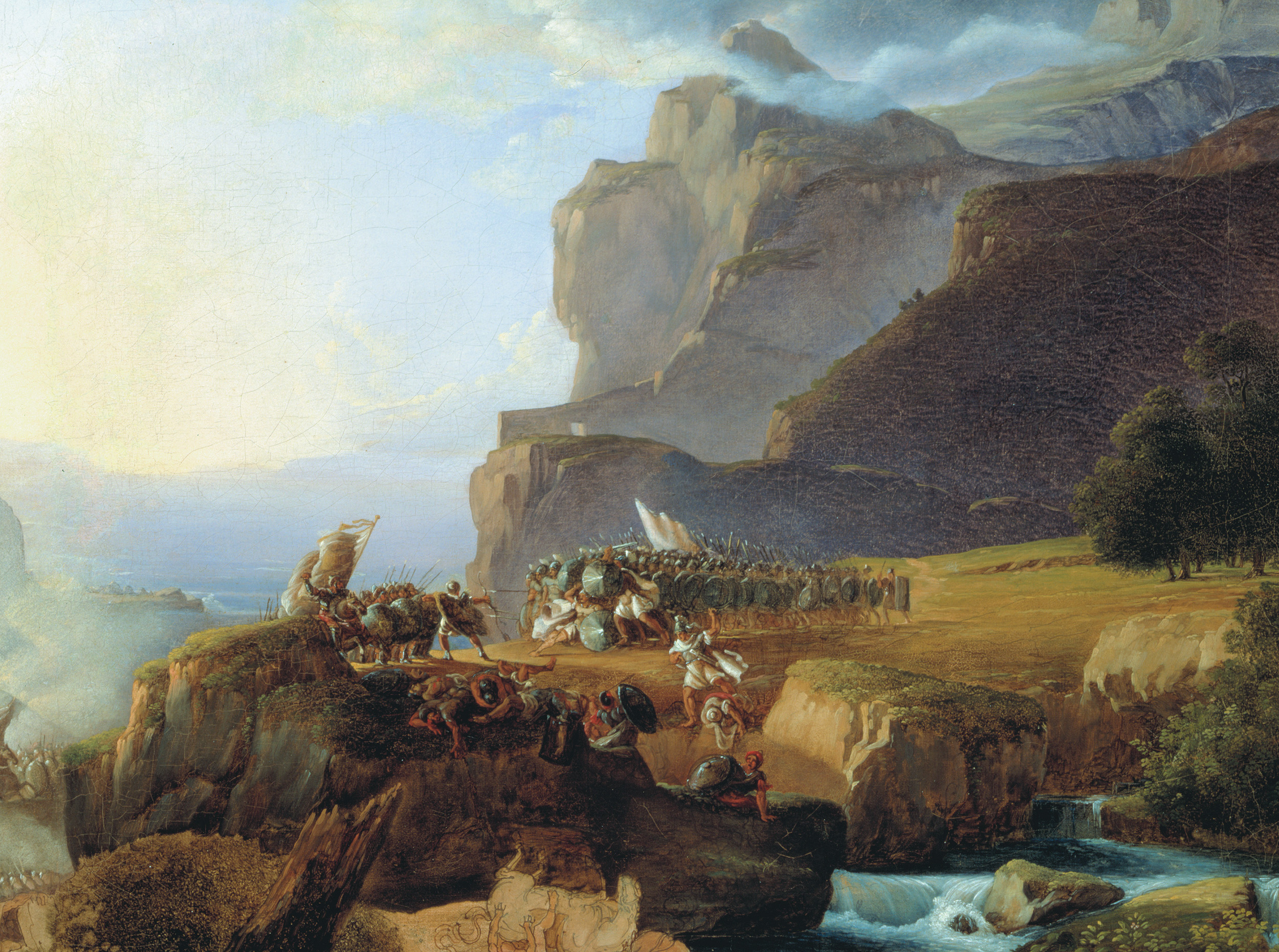
“Have a Good Breakfast, Men, for Tonight We Dine in Hades,”
Another possibility, suggested by the historians Bury and Meiggs, is that the retreating Greeks initially planned to fall back to the eastern juncture of the path and the high trail and catch the Immortals in the rear. If so, they were vanquished by the Immortals.
With the sunrise of the third day of battle, Leonidas watched his faithful Spartan bodyguards eat their morning meal and comb their hair. “Have a good breakfast, men, for tonight we dine in Hades,” he told them. They donned their fierce Corinthian helmets and strapped on their great shields. For the last time they followed their king to Thermopylae’s western narrows.
In the valley below, Xerxes poured a libation to Ahuramazda. Once more his soldiers hiked up to the defile, heartened by the hope that soon the Immortals would fall on the rear of their obstinate enemy.
As Leonidas watched them approach, the prophecy of Delphi ran through his mind.
“Either your glorious town shall be sacked by the Children of Perseus
Or, in exchange, must all through the whole Laconian country
Mourn for the loss of a king, descendant of great Heracles.”
He now understood that he was that king. But he and his warriors would go out in a blaze of glory! Leonidas marched his men out of the defile to take the fight to the enemy.
There rang the clamor of crashing spears, the shredding of shields, the cries of battle, and the crying of the wounded. Heedless of their own lives, the Spartans ploughed into the Persian masses, driving many into the sea where they drowned beneath the waves. Their spears shivered, the Spartans drew short, inward-curved, cleaver-like blades and hewed into their foes.
Two brothers of Xerxes fell that morning. Leonidas too perished after taking a bloody toll of his foes. A battle of Homeric proportions raged over his body. Four times the two sides pressed each other back and forth. When at last the Spartans recovered Leonidas’s body, a shout broke out to the rear … here come the Immortals! Forthwith the Spartans fought their way back into the defile and behind the wall. Upon a hillock they joined the Thespians and prepared for the end.
The Thebans, on the other hand, so Herodotus tells us, threw their arms aside and came forward with their hands outstretched in surrender. Although some were killed in the heat of the moment, the majority were taken prisoner and branded with Xerxes’ mark as a sign of distinction. Historians, however, have pondered if the Thebans’ act of cowardice is justified, a result of Herodotus’s pro-Athenian (Athenians being traditionally anti-Theban) leanings or of Thebes’ subsequent submission to Persia.
Xerxes’ men pressed forward, demolishing part of the wall. Joined by the Immortals, the Persian juggernaut flung itself at the last bastion of the sons of Hellas. Their weapons shattered, the Greeks fought on with hands and teeth. Even in their death throes, they were as dangerous as wounded lions.
At last the Persians called back their men and formed up ranks upon ranks of archers. One Spartan named Dienekes replied to the remark that the Persian arrows would darken the sun, “So much the better; we shall fight in the shade.” Volley after volley showered upon the Greeks, the sharp arrowheads puncturing ragged armor and shields. With each volley, hoplites watched as beside them a comrade succumbed to the enemy’s fire. Wooden dog tags hung around the Spartans’ necks, but soon there was no one left who would care to read them. The Spartans did not flinch, nor cower in fear, but stood proud until all were slain. The lighter armed helot hoplites perished beside their masters, as did the Thespians, for whom it meant the loss of virtually the entire male population of their city.
The Bloody and Inspirational End to the Battle of Thermopylae
On the same day, the bronze rams of Persian and Greek triremes collided in the battle of Artemisium. The battle was out on the open sea and losses were heavy on both sides. Although the Persians had the better of it, nothing decisive was achieved. In any case, with the fall of Thermopylae the Greeks pulled their fleet back to Athens.
By midday, it was all over, and Xerxes himself came to the battlefield. He ordered the Persian dead to be buried; there was no need for the rest of his army to know how much Persian blood was spilled for so few Greeks. Days later Xerxes’ army finally marched past the hillock, leered at by Leonidas’s head. It had been struck off his body and mounted on a stake. In the end, even the descendant of Heracles and the sons of Sparta could not defy the Persian titan.
The dramatic last stand of Leonidas’s Spartans became the Greek personification of doomed heroism against impossible odds. Afterward, a column was erected at Sparta, inscribed with the names of Leonidas and his 300 Spartans plus Dienekes’ scornful comment in the hour of certain death. Upon the fateful hillock at Thermopylae, the keepers of Demeter’s shrine erected a stone lion. Inscribed upon it were the words, “Go, stranger, and to Lacedaemon tell, That here, obeying her behests, we fell.”
Xerxes’ had won the first round but Greece was not conquered yet. There would be other battles on land and at sea, battles during which the memory of the heroes of Thermopylae would inspire all of Greece.
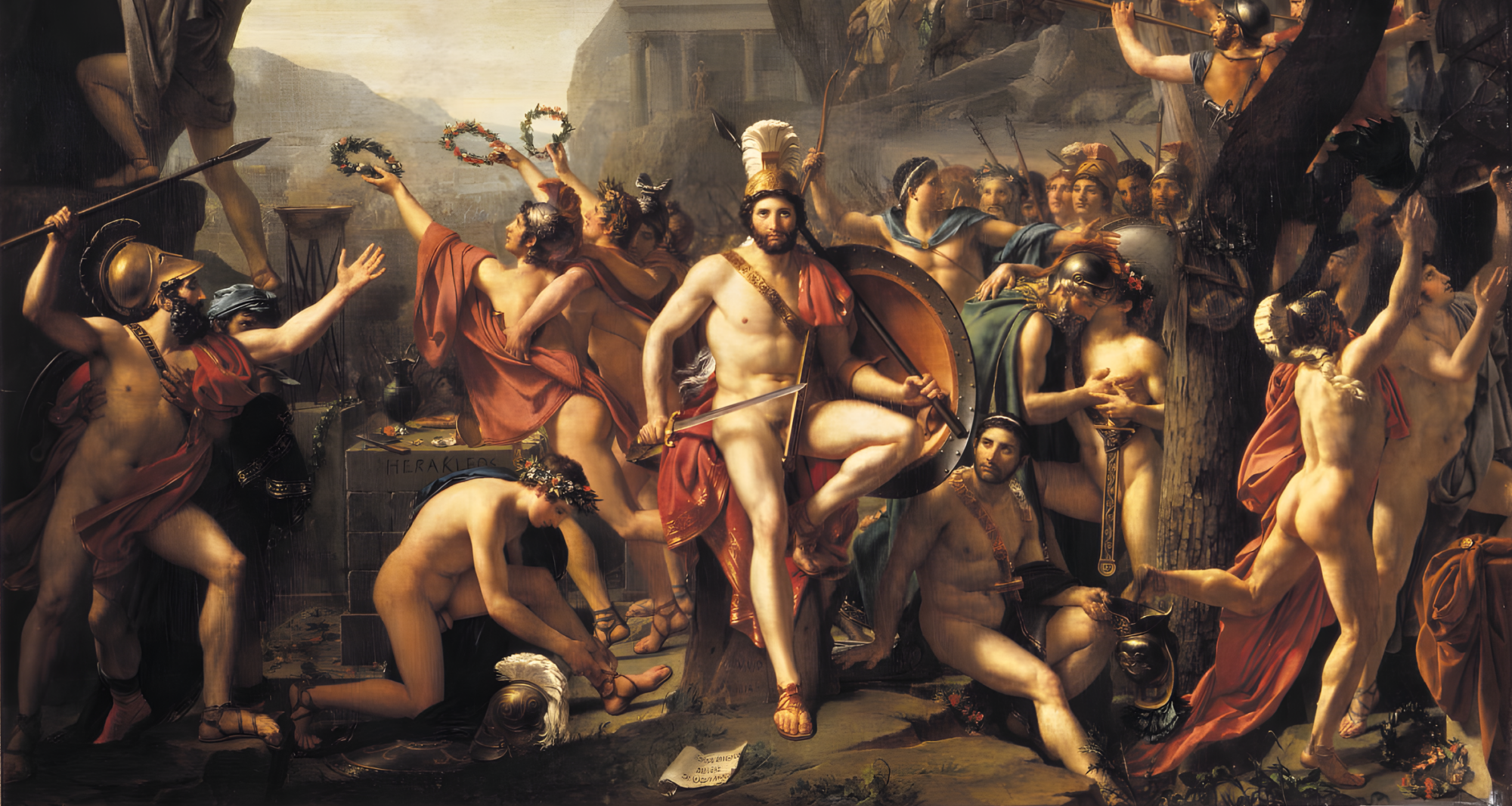


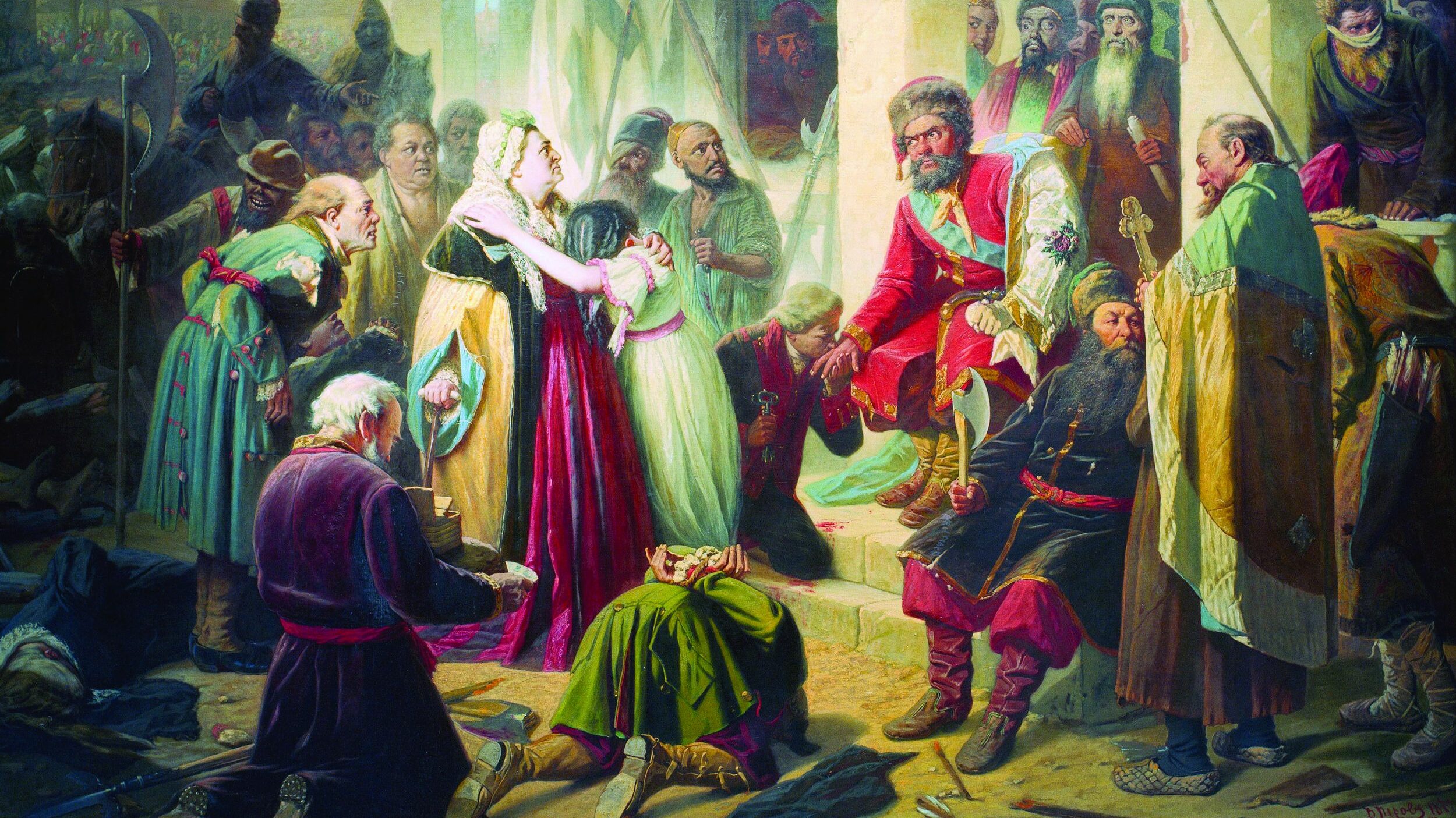
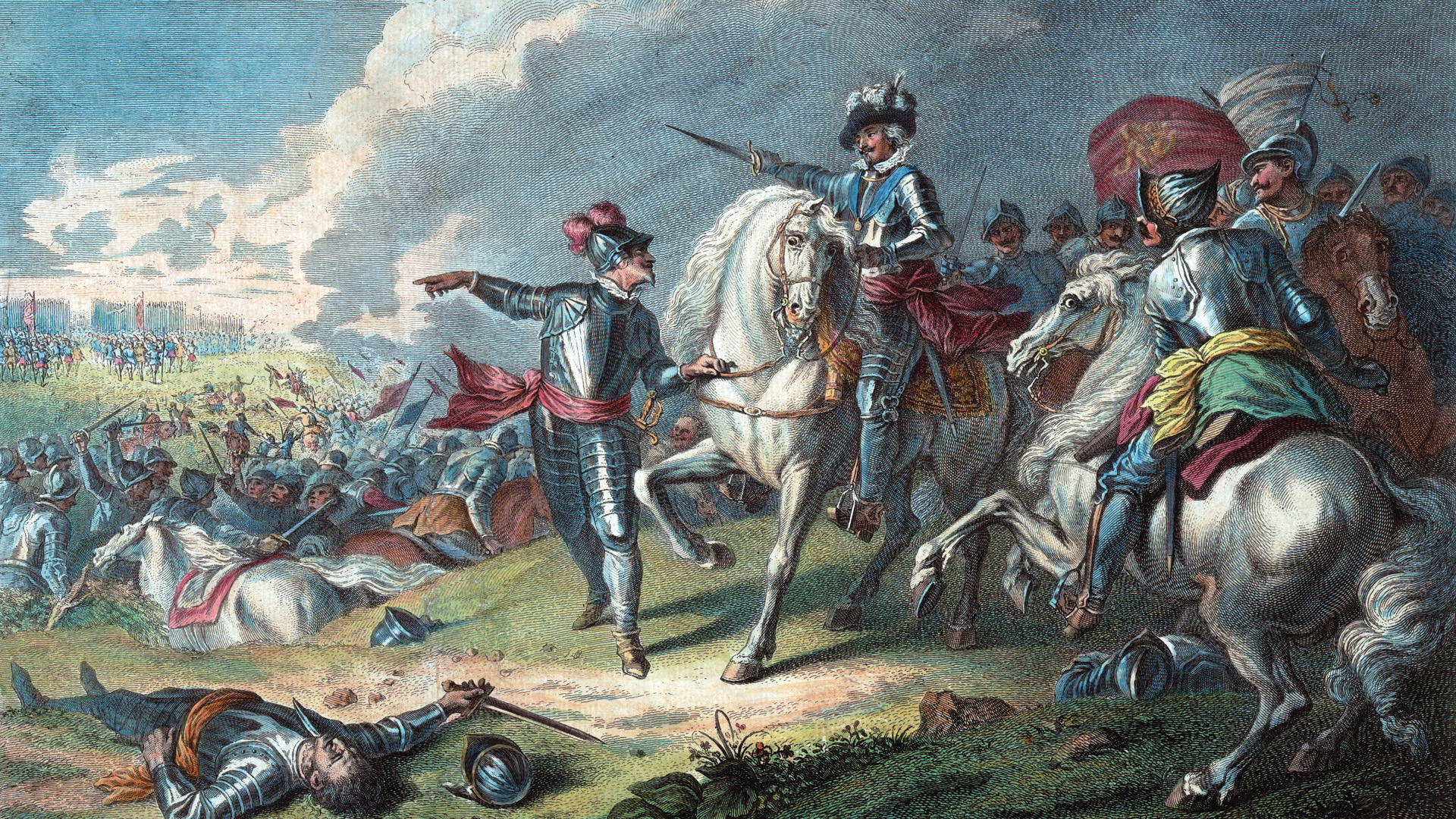
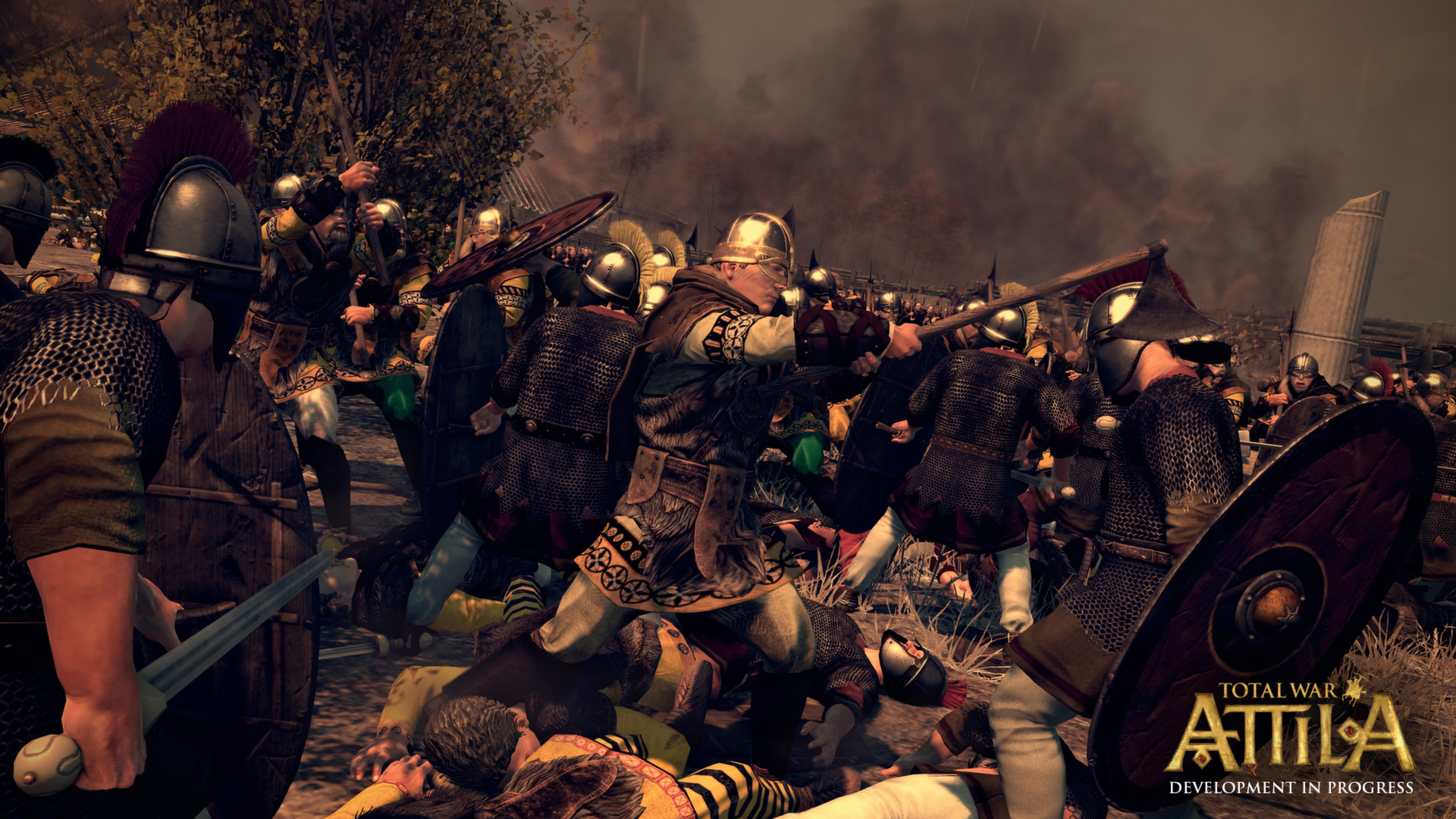
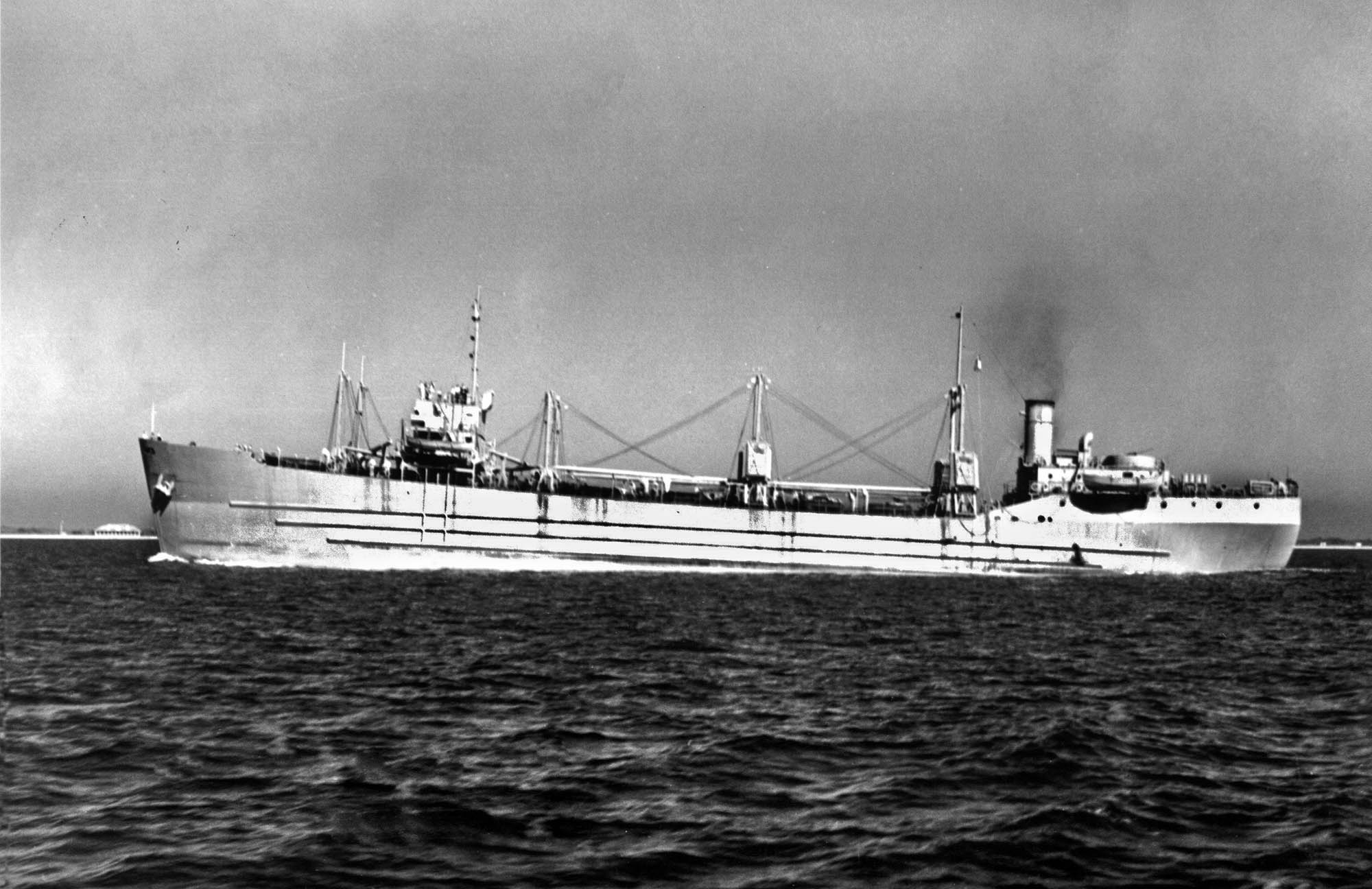

Brilliantly Scripted.